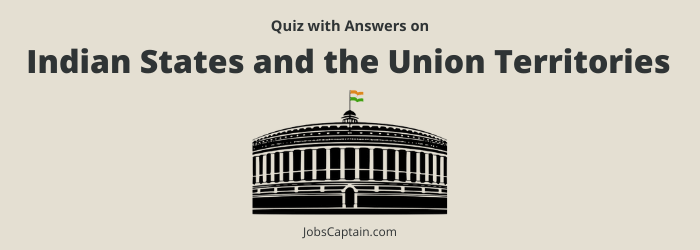
| Quiz Set | 1 | 2 | MCQ on Indian Polity and Governance |
Question 1:Which of the following Constitutional Amendments integrated Sikkim as a full-fledged State of the Indian Union?
(A) 34th
(B) 35th
(C) 36th
(D) 37th
Question 2: The Cauvery River Water dispute is among which of the following states?
(A) Karnataka – Maharashtra – Goa – Andhra Pradesh
(B) Karnataka – Tamil Nadu – Maharashtra – Kerala
(C) Karnataka – Tamil Nadu – Kerala – Andhra Pradesh
(D) Karnataka – Tamil Nadu – Puducherry – Kerala
Question 3: A separate Vananchal State carved out of Bihar can be made possible by ___________.
(A) Passing the legislation in State Assembly
(B) Passing the ordinance by the Governor
(C) Completing Constitutional formalities
(D) Parliament under Article 3 of the Constitution
Question 4: The Commission for Reorganisation of States on the basis of language was established in ___________.
(A) 1856
(B) 1956
(C) 1953
(D) 1960
Question 5: Which one of the following is the correct chronological order of the formation of the following states as full States of the Indian Union?
(A) Sikkim – Arunachal Pradesh – Nagaland – Haryana
(B) Nagaland – Haryana – Sikkim – Arunachal Pradesh
(C) Sikkim – Haryana – Nagaland – Arunachal Pradesh
(D) Nagaland – Arunachal Pradesh – Sikkim – Haryana
Question 6: The States were reorganised on the basis of language in ____________.
(A) 1956
(B) 1960
(C) 1962
(D) 1973
Question 7: Chhattisgarh State came into existence on ___________.
(A) 1 November 2000
(B) 9 November 2000
(C) 10 November 2000
(D) 1 January 2000
Question 8: In which year was the States reorganized on linguistic basis?
(A) 1947
(B) 1951
(C) 1956
(D) 1966
Question 9: Uttarakhand State was created in ___________.
(A) the year 1999
(B) the year 2000
(C) the year 2001
(D) the year 2002
Question 10: Which state enjoys the distinction of first being created on linguistic basis in India?
(A) West Bengal
(B) Punjab
(C) Tamil Nadu
(D) Andhra Pradesh
Question 11: The correct sequence of formation of the following States in ascending order is __________.
(A) Nagaland, Meghalaya, Sikkim, Arunachal Pradesh
(B) Meghalaya, Arunachal Pradesh, Nagaland, Sikkim
(C) Arunachal Pradesh, Nagaland, Sikkim, Meghalaya
(D) Sikkim, Nagaland, Arunachal Pradesh, Meghalaya
Question 12: Andhra Pradesh was created as a language based state in ___________.
(A) 1950
(B) 1953
(C) 1956
(D) 1961
Question 13: The correct sequence of the formation of the following States in descending order is __________.
(A) Maharashtra, Rajasthan, Haryana
(B)Haryana, Rajasthan, Maharashtra
(C) Rajasthan, Maharashtra, Haryana
(D) Haryana, Maharashtra, Rajasthan
Question 14: Consider the following statement and answer using codes given below.
- The term Union of States has been used in the constitution because Indian States, have no right of separation.
- S.K. Dhar Commission had given preference to administrative convenience rather language for reorganisation of States.
- Congress Committee including Jawaharlal Nehru, Sardar Patel, and Pattabhi Sitaramayya was not in favor of reorganization of States on the basis of language.
(A) Only 1
(B) Only 1 and 2
(C) Only 1 and 3
(D) All of the above
Question 15: Which of the following Province of India was formed in 1948?
(A) West Bengal
(B) Assam
(C) Punjab
(D) Himachal Pradesh
Question 16: Which one of the following is the correct chronological order of the formation of the following Indian States?
- Chhattisgarh
- Arunachal Pradesh
- Jharkhand
- Sikkim
Use the code given below to select the correct answer.
(A) 4, 1, 3, 2
(B) 4, 2, 1, 3
(C) 3, 2, 1, 4
(D) 1, 4, 2, 3
Question 17: One of the following statements is incorrect. Point out _________.
(A) The State of Mysore was renamed as Tamil Nadu
(B) Goa was separated from Daman and Diu
(C) The State of Bombay was split into Gujarat and Maharashtra
(D) Himachal Pradesh was previously in the list of Union Territories
Question 18: The following States were created after 1960. Arrange them in ascending chronological order of their formation.
- Haryana
- Sikkim
- Nagaland
- Meghalaya
Choose your answer from the given
(A) 1, 2, 3, 4
(B) 2, 3, 4, 1
(C) 3, 1, 4, 2
(D) 2, 4, 1, 3
Question 19: ‘ULFA’ extremist are related to which state __________.
(A) Assam
(B) Uttar Pradesh
(C) Punjab
(D) Jammu and Kashmir
Question 20: Identify the correct chronological order in which the following States were created in India from the code given below.
- Andhra Pradesh
- Himachal Pradesh
- Haryana
- Sikkim
Code
(A) 1, 2, 3, 4
(B) 1, 3, 2, 4
(C) 4, 3, 1, 2
(D) 3, 4, 1, 2
Question 21: ‘People’s War Group’ a terrorist organization is based in __________.
(A) Tripura
(B) Assam
(C) Nagaland
(D) Andhra Pradesh
Question 22:
- Assertion (A): India is not a federation.
- Reason (R): Union Parliament has the power to alter the area, boundary and name of any State even without its consent.
Select the correct answer from the code given below.
(A) Both (A) and (R) are true and (R) is the correct explanation of (A)
(B) Both (A) and (R) are true but (R) is not the correct explanation of (A)
(C) (A) is true, but (R) is false
(D) (A) is false, but (R) is true
| Quiz Set | 1 | 2 | MCQ on Indian Polity and Governance |
